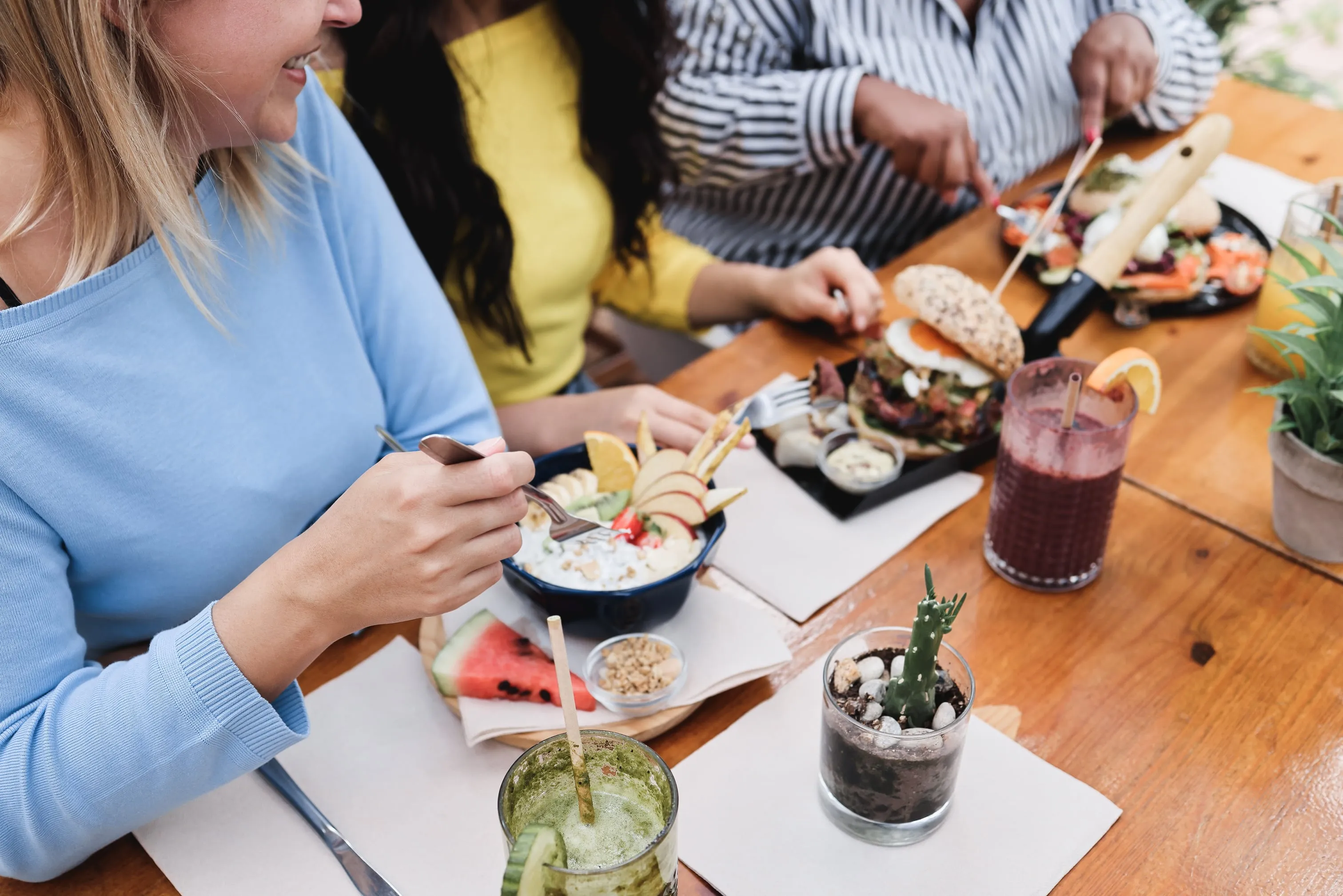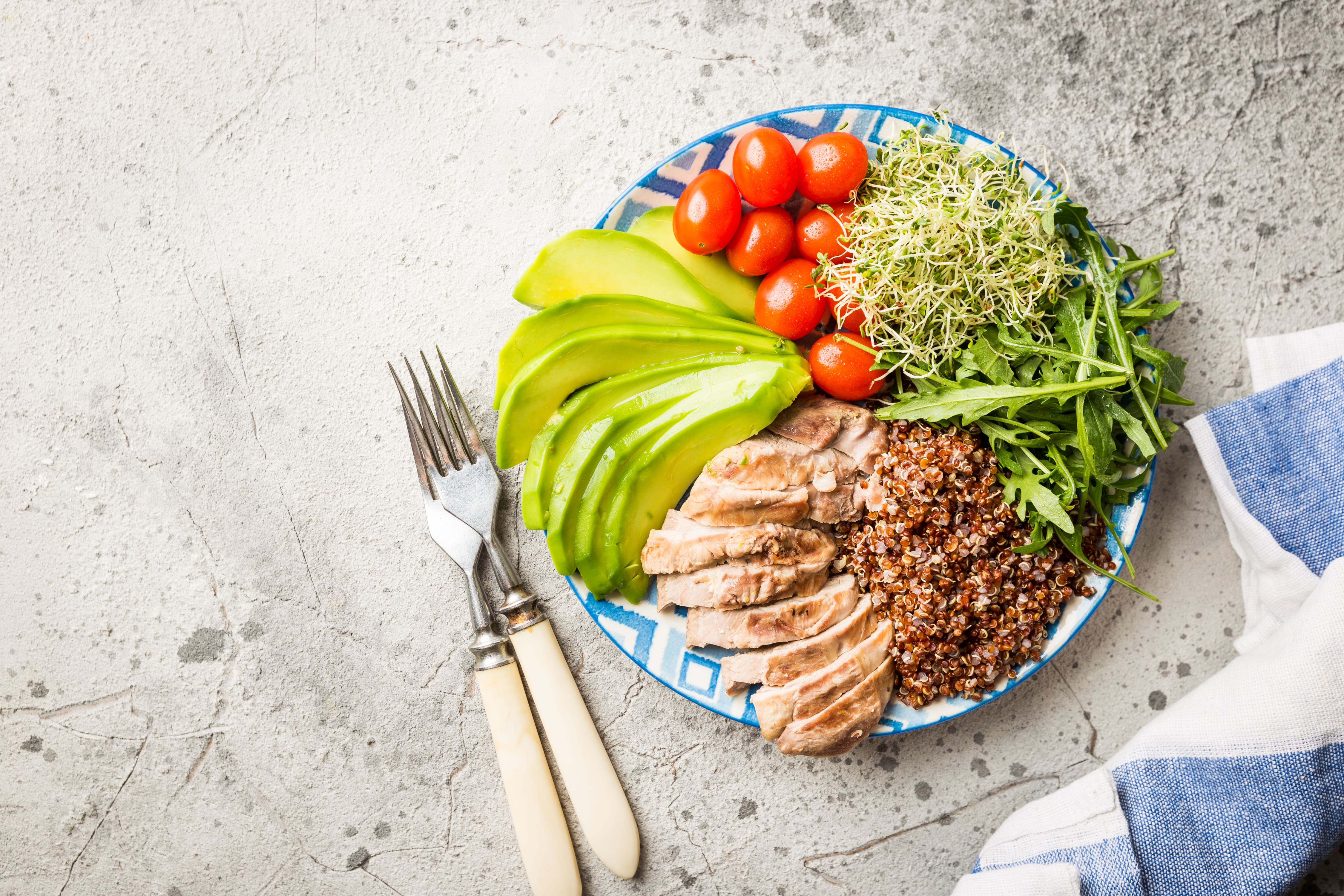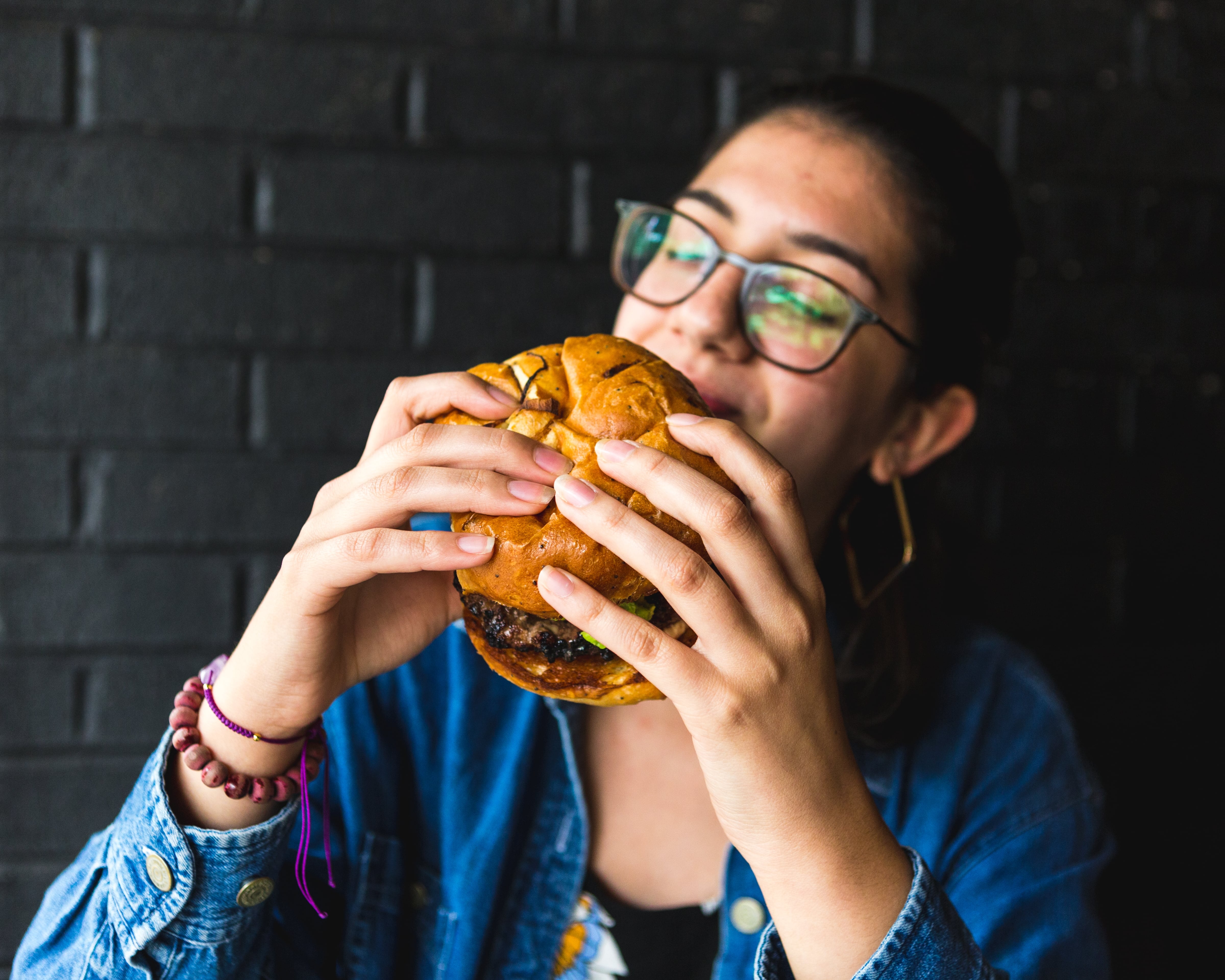Key Takeaways
- Food noise is a persistent mental chatter about food and eating, and can be influenced by hormones, emotional health, eating habits, and your environment.
- Hormonal shifts, erratic eating patterns, and strong emotions can make it difficult to distinguish between physical hunger and emotional or habitual hunger.
- Mindful eating, stress management, quality sleep, and eating regular, balanced meals can help quiet food noise and support your overall health, energy, and emotional well-being.
{{mid-cta}}
Food noise. You’ve probably felt it, even if you didn’t have a name for it. It’s that constant chatter in your head about what to eat next, the urge to snack right after a meal, or the way cravings can hijack your focus even when you’re not physically hungry.
With the rise of GLP-1 medications like Ozempic and Wegovy, more people are talking about food noise because these drugs seem to turn the volume down. But you don’t need a prescription to understand or manage it. Food noise is real, it’s exhausting, and in today’s food environment, it’s everywhere.
Let’s break down where it comes from, how your biology fuels it, and how to finally quiet the static so you can hear your body’s actual hunger cues.
What Is Food Noise, Really?

Food noise isn’t a medical term, but it’s an experience most people know all too well. It’s the constant stream of food thoughts: What’s for lunch? Should I grab a snack? Maybe I’ll check what’s in the pantry again, even if you just ate. It’s a distraction disguised as hunger.
Here’s where it comes from in real life:
Environmental Triggers
You’re scrolling social media at night and stumble on a recipe video. Suddenly, you’re in the kitchen hunting for something sweet, even though you had dinner an hour ago. Or you walk into the office and the smell of bagels derails your plan for the breakfast you packed. That’s not hunger; it’s cue-driven noise.
Wired Reward Systems
Your brain’s motivation-reward circuit is designed to light up at the sight, smell, or even thought of food. In a world where food was scarce, that wiring kept us alive. In today’s environment (where ultra-processed, hyper-palatable foods are everywhere), it becomes overwhelming. That’s why a single whiff of popcorn in the movie theater can make you feel like you need a tub, even if you just ate dinner.
Personal Factors
Stress, lack of sleep, and dieting history all crank up the volume. Think about the nights you stayed up late working: by midnight, you’re in front of the fridge, not because you’re truly hungry, but because exhaustion and stress dialed up food noise. Some people are simply more sensitive than others, thanks to genetics, past dieting cycles, or emotional eating patterns.1,2
Bottom line: food noise is not a willpower issue. It’s your biology colliding with an environment that’s built to keep you thinking about food nonstop.
The Biology of Cravings: Hormones at Work

Cravings don’t just live in your head; they live in your hormones. Three key players control when and why you feel hungry, full, or driven toward that cookie:
- Ghrelin rises when your stomach is empty, signaling hunger.
- Leptin tells your brain you’ve had enough, creating a sense of fullness.
- Dopamine drives the reward response, making certain foods feel irresistible.
When you’re well-rested, well-fed, and less stressed, these hormones work together seamlessly. But modern life scrambles the signals.
- Sleep loss and stress: You stayed up binging a show, then dragged yourself into work on four hours of sleep. By 10 a.m., ghrelin is surging, leptin is low, and suddenly the office pastries feel impossible to resist.3,4,5
- Erratic eating: You skip lunch, then crash mid-afternoon. Your brain pushes dopamine into overdrive, demanding a quick-hit energy fix like chips or candy.
- Hormonal shifts: During certain points in the menstrual cycle, estrogen and progesterone changes drive stronger cravings for carbs or sweets, which is why ice cream suddenly feels like a non-negotiable.
- Rapid glucose swings: That giant frappuccino in the morning spikes your glucose sky-high, followed by a crash an hour later. The crash leaves your brain in panic mode, begging for another quick sugar hit.
Over time, repeated dieting or weight cycling can even rewire dopamine pathways, making food cues louder and cravings harder to resist. That’s why someone who has restricted heavily in the past may find themselves hyper-focused on food, even when they don’t want to be.6,7
The takeaway: cravings aren’t random, and they’re not about weak willpower. They’re your hormones responding to exhaustion, stress, restriction, or glucose swings. Once you stabilize the system, the food noise starts to quiet down.
Real Hunger vs. Habit Hunger
One of the trickiest parts of navigating food noise is figuring out whether you’re actually hungry or if your brain is just reacting to a cue, habit, or emotion. Both feel urgent, but they come from different places in the body.
Real Hunger
This is your body’s physiological need for energy. It builds gradually, not suddenly. Your stomach might growl, you may feel lower energy, or you may notice you’re less focused. Once you eat a balanced meal or snack, the hunger eases and you feel satisfied.
Example: You ate lunch at noon, worked through the afternoon, and by 5 p.m., you’re genuinely low on energy and starting to feel irritable. You grab dinner and feel better within 20 minutes. That’s true hunger doing its job.
Habit Hunger
This is hunger that’s learned, triggered, or emotional, not based on your body’s actual energy needs. It often shows up suddenly and specifically (craving ice cream, not just “food”). It doesn’t always ease after eating, especially if the root cause wasn’t physical hunger.
- Cue-driven: You always grab popcorn at the movies, even if you just ate. Your brain associates the environment with eating, so the craving switches on.
- Emotional: Stress at work leads you to the vending machine, not because your stomach is empty, but because your brain is looking for comfort.
- Routine: You’ve trained yourself to want a snack every night in front of the TV. Even if you ate dinner an hour ago, the habit cue flips on automatically.
Why It Matters
If every craving feels like “real” hunger, food noise gets louder and harder to navigate. The more you can distinguish between the two, the more choice you have. That doesn’t mean you should never answer habit hunger (sometimes comfort food really is comforting), but knowing the difference helps you respond intentionally instead of automatically.
- Real hunger asks: What fuel does my body need right now?
- Habit hunger asks: What else might I be craving: rest, stress relief, a break, or simply a ritual?
Learning this distinction is a powerful way to lower food noise. It shifts you out of reacting and into observing, which helps bring the volume down.
Quieting the Noise: What Actually Works

Food is fuel, yes. But it’s also pleasure, connection, culture, and comfort. Quieting food noise isn’t about shutting off cravings or silencing your appetite; it’s about learning how to tune the volume so your hunger cues come through clearly, and the static fades into the background.
Here’s how to turn down the noise:
1. Practice mindful eating
When eating feels automatic, it’s easy to miss your body’s signals. Slowing down puts you back in the driver’s seat. Before you eat, check in: Am I hungry? Where do I feel it? As you eat, pause midway. Notice: Does the food still taste as good as the first bite? How full am I getting? Aim to stop when you’re comfortably satisfied, not stuffed.
Pro tip: Try setting your fork down between bites or taking a sip of water as a pause. These tiny breaks help your body catch up with your brain’s fullness signals.
2. Balance your plate
Meals that combine protein, fiber, and healthy fat do more than “fill you up;” they stabilize your glucose and hormones, which directly quiets food noise. A blood sugar rollercoaster makes cravings louder; steady glucose keeps them in check.
Think: salmon, quinoa, and roasted veggies with olive oil, or Greek yogurt with berries and nuts. You’ll feel satisfied longer and less likely to go searching for snacks an hour later.
3. Protect your basics
Cravings often spike not because of food itself, but because of what’s happening in the background: poor sleep, high stress, long gaps without meals.
- Sleep: Even one night of short sleep can raise ghrelin (hunger hormone) and lower leptin (fullness hormone), leaving you hungrier and less satisfied.
- Stress: Cortisol pushes your body toward quick-energy foods, usually sugar and refined carbs.
- Regular meals: Erratic eating patterns lead to glucose dips and spikes, which make food noise louder.
Nail these basics, and your hunger cues become clearer and easier to trust.
4. Remove distractions
When your brain is busy scrolling, bingeing a show, or multitasking, it can’t fully register the sensory experience of eating, or the satisfaction that follows. That delay often leads to eating past fullness.
Try one meal a day without screens. Notice the flavors, textures, and how your body feels as you eat. It’s not about eating in silence; it’s about letting your brain actually experience your meal.
5. Give yourself permission
Restriction cranks food noise to maximum volume. The more you forbid a food, the louder your brain demands it. Sometimes the cookie is the right call. Eating it mindfully, without guilt, helps you enjoy it (and move on) without spiraling into the all-or-nothing trap.
The real win is flexibility: choosing the foods that serve your body most of the time, and enjoying the ones that feed your soul when you want them.
Craving ≠ Deficiency: Busting the Myth
“Craving chocolate? You must be low in magnesium.” You’ve probably heard that one before. Here’s the truth: aside from rare cases like iron deficiency causing a strong urge to chew ice, most cravings aren’t your body signaling a missing nutrient.
Instead, cravings are usually about:
- Variety: When your diet is monotonous, your brain amplifies food noise. In fact, research shows that bland, repetitive eating makes tempting foods (like pizza or cake) even harder to resist when you see or smell them.9,10
- Emotions: Stress, boredom, loneliness, and celebration are all classic craving triggers. Food becomes an easy, accessible way to self-soothe or to enhance joy.
- Sensory overload: Food ads, TikTok recipes, smells wafting from the office kitchen: your brain is wired to respond to these cues, whether you’re hungry or not.
So no, your body doesn’t secretly “need” pizza because it’s low in pepperoni. It’s your brain reacting to a mix of biology, psychology, and environment.8
What To Do Instead: Practical Tools for Managing Cravings

Cravings aren’t a character flaw; they’re information. The key is learning how to respond with strategy, not autopilot.
1. Use the 10-minute pause
When a craving hits, set a timer. In those 10 minutes, check in with yourself: Am I tired? Thirsty? Stressed? Bored? Sometimes cravings fade once you meet the real need (like grabbing water or taking a quick walk). And if the craving is still strong after 10 minutes? Have the food, mindfully.
2. Pair fun foods with nutrient-dense ones
Instead of fighting cravings, anchor them. Want chips? Pair them with guacamole for fiber and healthy fats. Craving chocolate? Try it with a handful of almonds. You still get the flavor you want, but with added satiety and balance.
3. Build “structured flexibility”
Rather than waiting until cravings boil over, weave in small amounts of the foods you love intentionally. A square of dark chocolate after dinner, Friday pizza night with a salad on the side: planned enjoyment reduces food noise because your brain trusts that nothing is truly off-limits.
4. Check your patterns
If cravings are strongest at night, look upstream. Did you skip breakfast? Did your lunch lack protein? Did stress pile up all day? Often, the best craving strategy happens hours earlier, by balancing meals and regulating your energy curve.
5. Reframe the craving
Instead of seeing it as a command (“I need ice cream now”), view it as a signal. Ask: What is this craving pointing me toward? Comfort? Pleasure? Energy? Sometimes, the answer is food. Other times, it’s a walk, a nap, or calling a friend.
Together, these strategies take cravings from feeling like an enemy to manage into a signal you can interpret (and respond to) on your terms.
Bottom Line: Food Noise Isn’t About Willpower
Food noise isn’t a flaw, a lack of discipline, or something to “fix” by cutting harder, dieting stricter, or fighting cravings until they disappear. It’s your biology (hunger hormones, reward circuits, glucose fluctuations) colliding with a modern food environment designed to keep your appetite switched on.
That’s why strategies like mindful eating, balanced meals, solid sleep, stress management, and permission-based flexibility matter. They don’t “silence” cravings entirely, but they recalibrate the system so hunger cues become trustworthy, and cravings lose their grip.
And this is where tools like a continuous glucose monitor (CGM) add clarity. Food noise often gets loudest when your glucose spikes and crashes, leaving your brain desperate for fast fuel. By seeing how your body responds to different meals in real time, you can spot the patterns that make cravings roar versus fade.
- A steady glucose curve means quieter cravings, clearer hunger signals.
- A rapid spike-and-drop equates to louder food noise, harder choices.
With Signos, you’re not guessing; you’re learning directly from your own data. Over time, those insights make it easier to pair the right foods, build balanced meals, and practice mindful eating in a way that’s personal, not generic.
The bottom line: food noise isn’t about willpower; it’s about wiring. And when you understand your biology, you can finally quiet the noise and tune into what your body really needs.
Learn More With Signos’ Expert Advice
Distinguishing between physical hunger and emotional or habitual hunger is a great step towards honoring your body’s needs and taking care of your health. To support your body even further, Signos can help you understand how specific foods impact your blood glucose and energy levels, whether you’re managing type 2 diabetes or on a healthy and wellness journey to feel your best.
Topics discussed in this article:
References
- Hayashi, D., Edwards, C., Emond, J. A., Gilbert-Diamond, D., Butt, M., Rigby, A., & Masterson, T. D. (2023). What is food noise? A conceptual model of food cue reactivity. Nutrients, 15(22), 4809. https://doi.org/10.3390/nu15224809
- Dhurandhar, E. J., Maki, K. C., Dhurandhar, N. V., Kyle, T. K., Yurkow, S., Hawkins, M. a. W., Agley, J., Ho, E. H., Cheskin, L. J., Sørensen, T. I. A., Wang, X. R., & Allison, D. B. (2025). Food noise: definition, measurement, and future research directions. Nutrition and Diabetes, 15(1). https://doi.org/10.1038/s41387-025-00382-x
- Van Egmond, L. T., Meth, E. M. S., Engström, J., Ilemosoglou, M., Keller, J. A., Vogel, H., & Benedict, C. (2022). Effects of acute sleep loss on leptin, ghrelin, and adiponectin in adults with healthy weight and obesity: A laboratory study. Obesity, 31(3), 635–641. https://doi.org/10.1002/oby.23616
- Chao, A. M., Jastreboff, A. M., White, M. A., Grilo, C. M., & Sinha, R. (2017). Stress, cortisol, and other appetite-related hormones: Prospective prediction of 6-month changes in food cravings and weight. Obesity, 25(4), 713–720. https://doi.org/10.1002/oby.21790
- Jacques, A., Chaaya, N., Beecher, K., Ali, S. A., Belmer, A., & Bartlett, S. (2019). The impact of sugar consumption on stress driven, emotional and addictive behaviors. Neuroscience & Biobehavioral Reviews, 103, 178–199. https://doi.org/10.1016/j.neubiorev.2019.05.021
- Dunigan, A. I., & Roseberry, A. G. (2022). Actions of feeding-related peptides on the mesolimbic dopamine system in regulation of natural and drug rewards. Addiction Neuroscience, 2, 100011. https://doi.org/10.1016/j.addicn.2022.100011
- Yu, Y., Miller, R., & Groth, S. W. (2022). A literature review of dopamine in binge eating. Journal of Eating Disorders, 10(1). https://doi.org/10.1186/s40337-022-00531-y
- Kumar, S., Jain, S., Sinha, S. K., & Chaudhury, S. (2024). Pagophagia: A case series. Industrial Psychiatry Journal, 33(1), 175–178. https://doi.org/10.4103/ipj.ipj_178_23
- Pelchat, M. L., & Schaefer, S. (2000). Dietary monotony and food cravings in young and elderly adults. Physiology & Behavior, 68(3), 353–359. https://doi.org/10.1016/s0031-9384(99)00190-0
- Meule, A. (2020). The Psychology of Food Cravings: the Role of Food Deprivation. Current Nutrition Reports, 9(3), 251–257. https://doi.org/10.1007/s13668-020-00326-0




.svg)










.svg)
.svg)
.svg)
.svg)
.svg)
.svg)
.svg)
